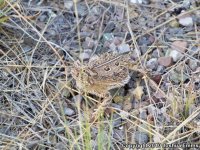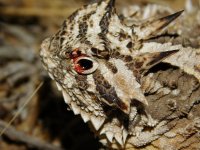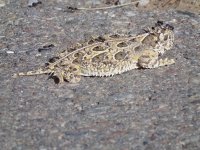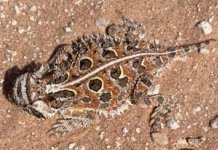| Range: |
 |
| Other Names: |
Horned Lizard, Horned Frog, Horned Toad, Horny Toad |
| Description: |
White midback stripe; two rows of lateral fringe scales; dark lines going up face and over top of head; sharp spines over eyes; two occipatal horns pointing upward; ventral scales weakly keeled. It is a large, robust species. The adult generally measures 2.7 to 4.5" SVL. Its horns are prominent; the medium pair is the longest and these horns are nearly conical in cross-sectional form. The back is very spiny, and there are two rows of enlarged fringe scales along each side of the body. Prominent, nearly erect, spiny scales are scattered over the upper surface. One of these scales is centered in each of several dark brownish spots on the back. These spots are located in lines along each side of the back and are bordered on their rear margin by cream-colored or yellow crescents. |
| Similar Species: |
The white stripe down the back bordered by black and the dark brown stripes that radiate downward from the eyes to the upper lip and extend upward from the eyes across the top of the head make this lizard easily distinguishable from other horned lizards. Short-horned Lizards can have a similar pattern, but lack the bold white stripe lined with black. |
| Venom: |
None |
| Habitat: |
Variety of arid and semi-arid habitats in open country having scant vegetation. Grasses often present along with scattered cacti, yucca, mesquite, acacia, juniper or other woody shrubs and small trees. |
| Behavior: |
Diurnal, will bask in mornings or late afternoon. They will run in short bursts. Can squirt blood out of their eyes when attacked by predators. They will puff themselves up to look bigger. |
| Hibernation: |
Hibernate underground during the cool months. |
| Reproduction: |
Males will get aggressive towards other males during the breeding season (spring to mid-summer), especially when females are around, but are not territorial. During copulation, malesgrasp females by their occipital horns. Lays clutches of 13-50 eggs, averaging 25. Bigger females will produce larger clutches. Eggs hatch from mid-summer to early fall. |
| Diet: |
Two thirds of their diet consists of ant, mainly Harvester Ants. They can detoxify native ant venom. The other one third consists of beetles and grasshoppers. |























